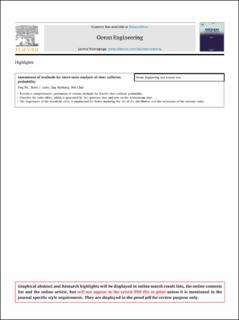| dc.contributor.author | Fu, Ping | |
| dc.contributor.author | Leira, Bernt Johan | |
| dc.contributor.author | Myrhaug, Dag | |
| dc.contributor.author | Chai, Wei | |
| dc.date.accessioned | 2022-03-10T10:09:01Z | |
| dc.date.available | 2022-03-10T10:09:01Z | |
| dc.date.created | 2021-08-27T06:29:52Z | |
| dc.date.issued | 2021 | |
| dc.identifier.citation | Ocean Engineering. 2021, 238 . | en_US |
| dc.identifier.issn | 0029-8018 | |
| dc.identifier.uri | https://hdl.handle.net/11250/2984202 | |
| dc.description.abstract | Reliability- and performance-based design of a riser cluster requires an accurate estimation of the extreme values of the stochastic relative distance between the risers during a given time duration. This study presents a comprehensive assessment of six methods for estimating the collision probability between two risers with limited simulation length. A pair of steep-wave risers in tandem arrangement subjected to combined current and wave loads is modeled. The wake effect generated by the upstream riser acting on the downstream riser is considered.
Firstly, the critical locations at which collisions during a short duration are likely to occur are identified. After obtaining nonlinear riser responses, 3-hour short-term extreme relative motions are calculated, which are used for the collision probability estimation. Several methods for the extreme value analysis, including the Gumbel probability paper method, the general extreme value method and the average conditional exceedance rate method are presented. This paper also proposes two methods which offer reliable and satisfactory results for the extreme value analysis of highly skewed processes. | en_US |
| dc.language.iso | eng | en_US |
| dc.publisher | Elsevier | en_US |
| dc.rights | Attribution-NonCommercial-NoDerivatives 4.0 Internasjonal | * |
| dc.rights.uri | http://creativecommons.org/licenses/by-nc-nd/4.0/deed.no | * |
| dc.title | Assessment of methods for short-term analysis of riser collision probability | en_US |
| dc.type | Peer reviewed | en_US |
| dc.type | Journal article | en_US |
| dc.description.version | acceptedVersion | en_US |
| dc.rights.holder | This is the authors' accepted manuscript to an article published by Elsevier. Locked until 25.8.2023 due to copyright restrictions. | en_US |
| dc.source.pagenumber | 11 | en_US |
| dc.source.volume | 238 | en_US |
| dc.source.journal | Ocean Engineering | en_US |
| dc.identifier.doi | 10.1016/j.oceaneng.2021.109221 | |
| dc.identifier.cristin | 1929112 | |
| cristin.ispublished | true | |
| cristin.fulltext | postprint | |
| cristin.qualitycode | 1 | |

